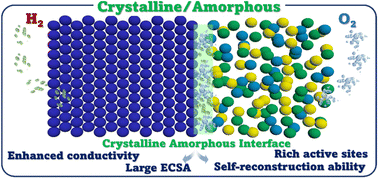A critical review on amorphous–crystalline heterostructured electrocatalysts for efficient water splitting
Abstract
Introducing complementary active materials in tandem as heterostructures of various shapes and sizes can significantly improve the physicochemical properties of the developed materials. Recently, the use of amorphous materials in conjunction with crystalline moieties as highly efficient electrocatalysts for water-splitting electrolyzers has surged rapidly. Excellent bifunctional activity for hydrogen evolution reaction (HER) and oxygen evolution reaction (OER) can be achieved from amorphous–crystalline-based materials owing to their remarkably conductive crystalline phase as well as their long-range disordered amorphous phase. In addition, the high specific surface area, disordered structure, and enhanced structural stability can accommodate various defects and strains that develop during in situ electrochemical reactions. Consequently, amorphous materials can be used as both surface-confined and volume-confined electrocatalysts. Although crystalline materials have better electronic properties as well as higher thermal and mechanical stability, they suffer from limited activity due to only surface-confined electrocatalysis. In this regard, the judicious integration of crystalline and amorphous active materials suitable for the OER and HER can tremendously enhance their bifunctional electrocatalytic activities owing to their synergistic effects. The variety in the choice of amorphous and crystalline counterparts presents ample opportunities for further exploration of the development of amorphous–crystalline heterostructured materials with unique properties. However, considering the recent massive developments in the understanding and protocols for fabricating such heterostructures, a critical review is vital for further advancement in this direction. Although some review papers have focused only on amorphous materials, including their synthesis methods, properties, and applications, no critical review that provides an overview emphasizing amorphous–crystalline heterostructures for electrocatalytic water-splitting applications has been published. In this regard, this review aims to present comprehensive details on the recent developments in the fabrication of different amorphous–crystalline heterostructures, the choice of the composition of each component, and the resulting physicochemical properties for the OER, HER, and overall water-splitting. It provides an in-depth understanding of amorphous–crystalline material synthesis protocols, their selection rationale, and their targeted physicochemical properties. This review also provides thought-provoking ideas and long-term perspectives for future research.

- This article is part of the themed collections: 2023 Materials Chemistry Frontiers Review-type Articles and 2023 Materials Chemistry Frontiers HOT articles


 Please wait while we load your content...
Please wait while we load your content...